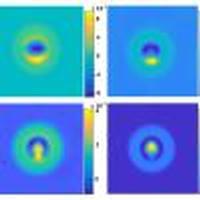当前位置:
X-MOL 学术
›
Opt. Express
›
论文详情
Our official English website, www.x-mol.net, welcomes your feedback! (Note: you will need to create a separate account there.)
Revisiting ultrafast laser inscribed waveguide formation in commercial alkali-free borosilicate glasses
Optics Express ( IF 3.8 ) Pub Date : 2020-03-24 , DOI: 10.1364/oe.387790 T. Toney Fernandez , Simon Gross , Alexander Arriola , Karen Privat , Michael J Withford
Optics Express ( IF 3.8 ) Pub Date : 2020-03-24 , DOI: 10.1364/oe.387790 T. Toney Fernandez , Simon Gross , Alexander Arriola , Karen Privat , Michael J Withford

|
Alkali-free borosilicate glasses are one of the most used dielectric platforms for ultrafast laser inscribed integrated photonics. Femtosecond laser written waveguides in commercial Corning Eagle 2000, Corning Eagle XG and Schott AF32 glasses were analyzed. They were studied in depth to disclose the dynamics of waveguide formation. We believe that the findings presented in this paper will help bridge one of the major and important gaps in understanding the ultrafast light-matter interaction with alkali-free boroaluminosilicate glass. It was found that the waveguides are formed mainly due to structural and elemental reorganization upon laser inscription. Aluminum along with alkaline earth metals were found to be responsible for the densification and silicon being the exchanging element to form a rarefied zone. Strong affinity towards alkaline earth elements to form the densified zone for waveguides written with high feed rate (>200 mm/min) were identified and explained. Finally we propose a plausible solution to form positive refractive index change waveguides in different glasses based on current and previous reports.
中文翻译:

再次探讨商用无碱硼硅酸盐玻璃中超快激光内接波导的形成
无碱硼硅酸盐玻璃是用于超快激光内切集成光子学的最常用介电平台之一。分析了商业康宁Eagle 2000,康宁Eagle XG和Schott AF32玻璃中的飞秒激光写入波导。他们进行了深入研究,以揭示波导形成的动力学。我们相信,本文介绍的发现将有助于弥合与无碱硼铝硅酸盐玻璃的超快光物质相互作用的主要和重要的差距之一。发现波导的形成主要是由于激光刻写时的结构和元素重组。发现铝和碱土金属是致密化的原因,而硅是形成稀疏区的交换元素。鉴定并解释了对碱土元素的强亲和力,形成了以高进给速率(> 200 mm / min)写入的波导的致密区。最后,根据当前和先前的报告,我们提出了一种可行的解决方案,以在不同的玻璃中形成正折射率变化波导。
更新日期:2020-03-31
中文翻译:

再次探讨商用无碱硼硅酸盐玻璃中超快激光内接波导的形成
无碱硼硅酸盐玻璃是用于超快激光内切集成光子学的最常用介电平台之一。分析了商业康宁Eagle 2000,康宁Eagle XG和Schott AF32玻璃中的飞秒激光写入波导。他们进行了深入研究,以揭示波导形成的动力学。我们相信,本文介绍的发现将有助于弥合与无碱硼铝硅酸盐玻璃的超快光物质相互作用的主要和重要的差距之一。发现波导的形成主要是由于激光刻写时的结构和元素重组。发现铝和碱土金属是致密化的原因,而硅是形成稀疏区的交换元素。鉴定并解释了对碱土元素的强亲和力,形成了以高进给速率(> 200 mm / min)写入的波导的致密区。最后,根据当前和先前的报告,我们提出了一种可行的解决方案,以在不同的玻璃中形成正折射率变化波导。



























 京公网安备 11010802027423号
京公网安备 11010802027423号